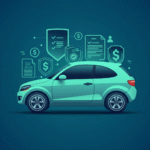Auto insurance is more than just a legal requirement—it’s a safety net that protects you from financial hardships in the event of accidents, theft, or unforeseen events. With a wide variety of coverage options and factors affecting your premiums, finding the right policy can feel overwhelming. This guide will break down the essentials of auto insurance, explain the different types of coverage, and share tips for choosing a policy that fits your needs and budget.
What Is Auto Insurance and Why Is It Important?
Auto insurance is a contract between you and an insurance company. By paying regular premiums, you ensure financial protection against risks associated with owning and driving a car, such as accidents, property damage, or injuries.
Why Auto Insurance Matters
- Legal Requirement
Most states require drivers to maintain a minimum level of liability insurance to legally operate a vehicle. Driving without coverage can result in fines, license suspension, and other legal penalties.
- Financial Protection
Accidents or unexpected incidents can lead to costly repairs, medical bills, or lawsuits. Auto insurance mitigates these expenses so you don’t end up financially drained.
- Peace of Mind
Having auto insurance reduces stress by ensuring you’re prepared for unforeseen situations. Whether it’s a fender bender or a major accident, you can focus on recovery rather than worrying about financial setbacks.
- Protects Your Assets
For most people, a car is a significant investment. Insurance ensures that damage or loss doesn’t completely derail your finances.
Types of Auto Insurance Coverage
Auto insurance isn’t one-size-fits-all. There are several types of coverage, each designed to address specific risks and scenarios.
1. Liability Insurance
Liability insurance is the most basic type of auto insurance and is legally required in most states. It protects you if you are at fault in an accident by covering damages to others.
What It Covers:
- Bodily Injury Liability: Medical expenses and lost wages for the other party in an accident.
- Property Damage Liability: Repairs to the damaged vehicle or other property, like fences or mailboxes.
Best For:
All drivers, since it is mandatory and provides essential financial protection in accidents where fault is established.
2. Collision Insurance
Collision insurance pays for the repair or replacement of your vehicle regardless of fault in an accident.
What It Covers:
- Damage to your vehicle caused by collisions with another vehicle or object.
- Reversal or overturning of your car.
Best For:
Drivers with financed or leased vehicles, or those with newer cars they want to protect.
3. Comprehensive Insurance
Comprehensive insurance covers damage or loss not caused by a collision. It’s ideal for protecting against unexpected incidents.
What It Covers:
- Theft.
- Vandalism.
- Natural disasters (e.g., floods, hail, wildfires).
- Falling objects.
- Damage from striking an animal.
Best For:
Drivers in high-crime areas, regions prone to extreme weather, or those with valuable vehicles.
4. Uninsured/Underinsured Motorist Coverage
While liability insurance is legally required, not all drivers comply or carry sufficient coverage. This insurance fills the gap when you’re the victim.
What It Covers:
- Medical expenses and vehicle repairs after an accident caused by an uninsured or underinsured driver.
- Hit-and-run accidents, in some states.
Best For:
Drivers in areas with high rates of uninsured motorists.
5. Personal Injury Protection (PIP)
Also called “no-fault insurance,” PIP covers medical costs and related expenses regardless of fault.
What It Covers:
- Medical bills for you and your passengers.
- Rehabilitation expenses.
- Lost wages due to injury.
- Funeral expenses, if applicable.
Best For:
Drivers in no-fault states or those without extensive health insurance.
Factors That Influence Auto Insurance Premiums
The cost of auto insurance isn’t fixed. Instead, it’s influenced by multiple factors unique to the driver, vehicle, and location.
1. Driving History
- Safe Drivers: A clean driving record often results in lower premiums.
- Traffic Violations or Accidents: Speeding tickets, reckless driving, or past claims can raise rates.
2. Vehicle Type
- Make and Model: High-end vehicles cost more to repair or replace.
- Safety Features: Cars with advanced safety technologies like lane assist or airbags may lower premiums.
3. Geographic Location
- Living in urban areas often increases premiums due to higher accident and theft risks. Rural areas typically offer lower rates.
4. Coverage and Deductibles
- Opting for higher coverage limits increases premiums.
- A higher deductible (the out-of-pocket amount before insurance kicks in) often reduces upfront costs.
5. Age and Gender
- Young, inexperienced drivers pay higher rates due to increased risk.
- Statistically, male drivers in certain age groups tend to incur higher premiums.
6. Claims History
Frequent past claims may signal higher risk and result in elevated rates.
Tips for Choosing the Right Auto Insurance Policy
Finding the right policy requires balancing coverage needs, costs, and personal circumstances. Here’s how to make an informed decision:
1. Evaluate Your Needs
Start by considering:
- The value and age of your vehicle.
- Your driving habits (e.g., long commutes vs. occasional trips).
- Financial ability to pay for repairs or damages out-of-pocket.
2. Research and Compare Providers
Not all insurance companies offer the same value. Look for:
- Competitive rates and discounts.
- Positive customer reviews regarding claims handling.
3. Understand the Policy Terms
Before committing to a policy, understand:
- Coverage limits and exclusions.
- Deductibles and how they affect premium costs.
- State-specific requirements for coverage.
4. Ask About Bundling Options
Many insurers provide discounts if you combine policies, such as auto and homeowner’s insurance.
5. Consult an Insurance Agent
If you’re unsure about what coverage to choose, a professional agent can guide you based on your particular circumstances.
Strategies to Save Money on Auto Insurance
While comprehensive coverage may seem expensive, there are ways to save without compromising protection.
1. Maintain a Safe Driving Record
Good driver discounts reward those with a clean accident history.
2. Opt for Higher Deductibles
While this reduces premium costs, ensure you can afford the deductible out-of-pocket.
3. Seek Discounts
Check for options like:
- Multi-car discounts.
- Defensive driving course completion.
- Low mileage or usage-based insurance discounts.
4. Avoid Unnecessary Coverage
For old, low-value cars, ditching optional coverage (like collision) may be cost-effective.
5. Regularly Review Your Policy
Shop around annually to ensure you’re getting the best deal for your needs. Renewals aren’t always automatically the cheapest option.
Final Thoughts
Choosing the right auto insurance policy doesn’t have to be daunting. By understanding the types of coverage available, evaluating your needs, and considering factors that influence costs, you can create a tailored policy that offers robust protection and fits your budget. Whether you’re a seasoned driver or new to the road, investing in quality auto insurance is essential for peace of mind and financial security.
Take the time to compare options, ask questions, and ensure you’re covered for the unexpected. Remember, the cheapest policy isn’t always the best—adequate protection today can save you significant costs down the line.




